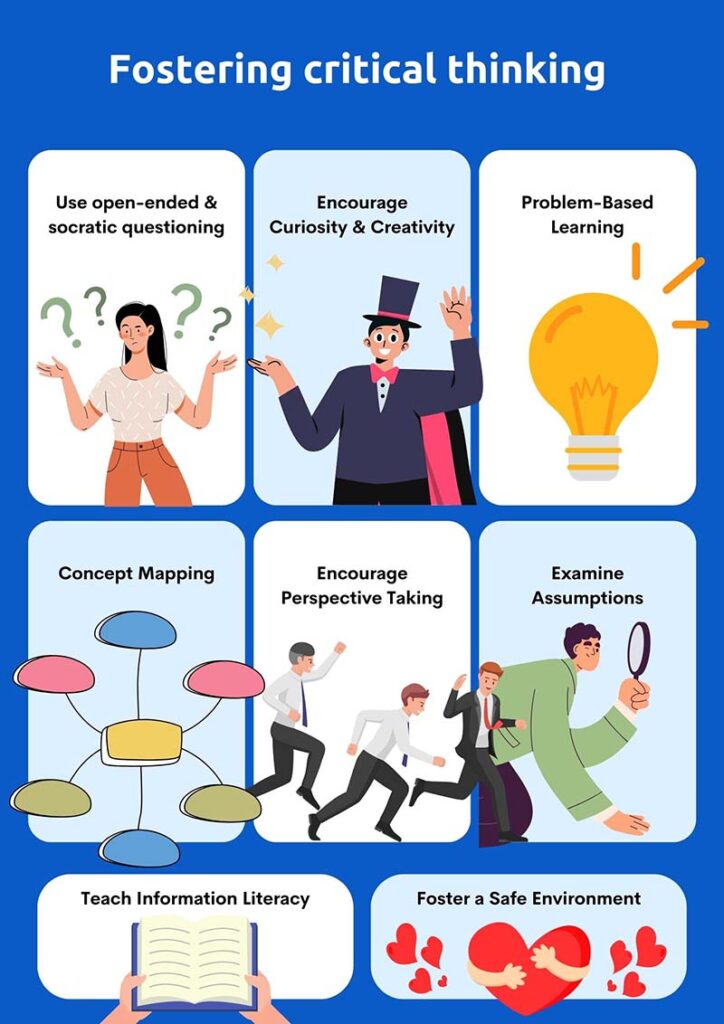
Nurturing bright minds: how teachers can foster critical thinking in students
Welcome, educators!
In the bustling classrooms of today, educators face a vital challenge: preparing students for a world that’s rapidly changing, unpredictable, and overflowing with information.
While it’s essential to instill traditional academic knowledge, there’s an ever-growing emphasis on another crucial skill—critical thinking.
But how does one teach a student to think critically?
How can we ensure that they don’t just memorize, but truly understand and reflect?
Dive in as we explore the strategies and techniques that every teacher can employ to nurture the next generation of thinkers, questioners, and innovators!

1. Questioning techniques
Let’s face it: the questions we ask in the classroom can either spark curiosity or dampen it. And as educators, we aim for the former, right? So, where should we start?
- Open-ended questions
Think back to a time when someone asked you a question that made you pause and reflect, rather than just recall a fact. That’s the magic of open-ended questions. They don’t just demand an answer; they invite thought, discussion, and even debate.
By asking questions that allow for a multitude of answers, we give students the freedom to express, argue, and validate their opinions, honing their analytical skills in the process.
- Socratic questioning
Stemming from ancient Greece, this method remains as relevant as ever. The art of Socratic questioning pushes students not just to answer but to delve deep into their thought processes. It’s about challenging them to clarify, justify, and sometimes even rethink their initial responses.
By prompting students to explore their assumptions and the validity of their ideas, we’re not just teaching them to answer. We’re teaching them to think, reflect, and understand the “why” behind their answers.
2. Encourage curiosity
In the heart of every student lies an innate sense of wonder, an unquenchable curiosity that seeks to understand the world. As educators, it’s our privilege and responsibility to cultivate this natural curiosity! One profoundly effective way to do this is by giving our students the platform to lead with their own questions. When a child poses a question, it’s a direct reflection of their interests and eagerness to learn. By acknowledging and exploring these queries, we’re not only validating their interests but also paving the way for deeper, more meaningful learning experiences. But the journey doesn’t stop there! As we open the doors to their questions, it’s equally vital to broaden their horizons by incorporating real-world events and issues into the classroom dialogue. It’s this synergy of personal curiosity and real-world relevance that truly sparks a lifelong passion for learning.
3. Problem-based learning
In today’s rapidly evolving world, it’s not enough for students to merely absorb information; they need to actively engage with it, dissect it, and reconstruct it in meaningful ways! Enter Problem-Based Learning (PBL), a dynamic approach that thrusts students into the epicenter of complex, real-world dilemmas. Instead of spoon-feeding them solutions, PBL nudges students to embark on intellectual quests, where the journey of finding the solution becomes as valuable as the solution itself. Imagine a classroom where instead of rote memorization, students are presented with multifaceted problems, mirroring the intricacies of our globalized world. Problems without straightforward answers, which require them to don the hats of researchers, analysts, and innovators. As they grapple with these issues, not only do they hone their critical thinking and collaborative skills, but they also become more resilient, learning to navigate the ambiguity and uncertainty that characterizes many of today’s challenges.
4. Concept mapping
Concept maps allow us to visualize the connections between different ideas or pieces of information, thereby facilitating a deeper understanding of a particular topic. Here are the benefits of concept mapping:
- Identifying hierarchies: Concept maps often have a hierarchical structure, helping us to discern primary ideas from secondary or tertiary ones.
- Connecting the dots: Knowledge isn’t just about learning isolated facts; it’s about understanding the symphony they create together. By interlinking varied ideas, concept maps pave the way for a harmonious synthesis of information, allowing new insights to emerge.
- Enhancing memory and recall: The visual nature of concept maps can help users remember and retrieve information more effectively.
- Clarifying ideas: Mapping out a concept can reveal gaps in understanding or inconsistencies in one’s thinking.
- Encouraging collaborative learning: Concept maps can be used as tools for group study or project planning, fostering discussions that enhance critical thinking.
5. Encourage perspective-taking
Imagine if every story only had one side to it. Boring, right?
Now, transfer that thought into the classroom setting. When we present students with problems or scenarios, there’s often an impulse to guide them towards the ‘right’ answer. But what if we shifted that approach?
Picture this: You present a dilemma in the classroom. It could be an ethical situation, a historical event, or even a literary conflict. Instead of seeking the ‘right’ answer, you nudge your students to explore the ‘many’ answers. You encourage them to slip into the shoes of various stakeholders involved, be it the protagonist, the antagonist, the observer, or even the environment!
This approach does wonders. Students start to see the nuances, question their own biases, and, importantly, build empathy. They’ll understand that many stories weave together to form the big picture. And in doing so, they not only become sharper thinkers but also kinder individuals.
6. Examine assumptions
Ever watched one of those mystery movies where the detective’s biggest breakthroughs often come from questioning the obvious? That’s kind of how analyzing assumptions works in the classroom.
We all operate based on certain assumptions, often without even realizing it. It’s like a mental shortcut – we’ve learned something previously, so we assume it to be true in other contexts. But here’s the thing: not all shortcuts lead to the right destination.
In the classroom, students often start their reasoning or build their arguments on certain assumptions. While some are valid, others can be way off base!
So, why not turn this into a learning opportunity? Next time they present an argument or share their thoughts, gently prod them. “Why do you think that is?” or “Is there a possibility that could be incorrect?” Questions like these challenge them to backtrack, identify the underlying assumptions, and weigh their validity.
The beauty of this exercise? It doesn’t just make them better thinkers; it makes them aware thinkers. They’ll start recognizing their own biases, understanding where their beliefs come from, and becoming more open to different perspectives.
7. Teach information literacy
With every scroll, click, and share, our students are plunged deeper into a whirlpool of information. The digital age is a double-edged sword: while access to information is unparalleled, so is the spread of misinformation.
This is where the importance of teaching information literacy takes center stage. As educators, it’s more than just imparting knowledge; it’s about equipping our students with a discerning eye. Can they differentiate a well-researched article from a baseless opinion? Are they mindful of the sources they rely on, ensuring they’re credible and unbiased?
We live in a time when ‘fake news’ is a real concern, and being able to discern between what’s genuine and what’s not can have profound implications on how our students understand and interact with the world!
8. Encourage creativity
When we talk about critical thinking, it’s easy to pigeonhole it into pure logic, dissecting arguments, or pinpointing fallacies. Yet, a vibrant aspect often overlooked is the realm of creativity. For every moment we spend teaching our students to analyze, shouldn’t there also be a moment where they’re prompted to invent, innovate, and imagine?
Critical thinking and creativity, seemingly distinct, are two sides of the same coin. Critical thinking lays the groundwork, digging deep into issues and exploring them from all angles. Creativity then steps in, using that well-laid foundation as a launching pad to new ideas, fresh perspectives, and uncharted territories.
Every student has a reservoir of creativity, waiting to be tapped. Our role as educators is to offer them the tools and the encouragement to bring their innovative ideas to the forefront. This could mean brainstorming sessions in the classroom, projects that don’t have a prescribed outcome, or simply a nudge to look at a familiar topic through a fresh lens.
In the end, by weaving creativity into the tapestry of critical thinking, we’re not just producing students who can critique the world but also those ready and eager to reshape it. Let’s give them the space to do both!
9. Foster a safe environment
If we truly want to foster critical thinkers, thinkers who aren’t afraid to challenge the status quo, to ask the hard questions, to venture into the unknown terrains of thought, we first need to give them the assurance that they are safe to do so!
This assurance comes when they know that their classroom is a safe harbor, a place free from ridicule, where mistakes are simply stepping stones to learning.
In the journey of developing critical thinking skills in students, before we introduce them to Socratic questioning or problem-based learning, our first step should always be to ensure they’re in a setting where they can freely express, debate, and even disagree. Because only when they’re at ease can they truly unleash the power of their minds!
Summary
Critical thinking isn’t just a skill; it’s an art, and like all arts, it thrives in a space where it’s nurtured and valued. As we wrap up our discussion, always remember: it’s the thinkers, the questioners, and the innovators who drive progress.
By championing these skills in our classrooms today, we are setting the stage for a more thoughtful, informed, and compassionate tomorrow!
At IELC, we teach English the right way
Our goal is to get you speaking in English with fluency and confidence as fast as possible. We want to give you the skills you need to fulfil your potential!
Our experienced teachers will guide you along every step of the learning process to ensure that you are not wasting your time, money, and energy on useless language exercises & wrong methods.
Our courses
With our modern campus and technology, we are equipped to provide the best possible courses for children, teens, and adults, including:
Online and on campus IELTS courses
Online and on campus TOEFL PBT courses
Online and on campus TOEFL iBT courses
We offer our classes in group classes or private classes.
No matter what your goals are, our team will help you achieve these goals by providing you with Indonesia’s best English courses!
Talk to our team today to get your FREE consultation and take your first step towards success.
Sincerely,

IELC Academic Director
